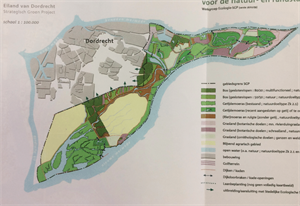Spatial Adaptation Living Lab in Dordrecht - Towards pilots with a lasting impact
Since 2017, the Climate Adaptation Living Lab in Dordrecht has been exploring promising measures to raise the climate resilience of the Dordrecht island. To this end, four pilots have been launched with support from the Ministry of Infrastructure and Water Management. Along with developing creative ideas and demonstrating the actual feasibility of any particular idea, the aim is to apply the outcomes of the pilots on a wider scale and to implement the principles throughout the organisation. The final report with the results was published in February: Pilots en hun doorwerking.
In 2016 and 2017, the Delta Programme provided grants to two Living Labs: Overijssel and Dordrecht. The results of the Overijssel Living Lab have already been published. The final results of, and the lessons to be learned from, the Dordrecht Living Lab are also now available. Within this Living Lab, the Hollandse Delta district water board and the municipality of Dordrecht are collaborating on the climate resilience of the Eiland van Dordrecht island through a combination of research, innovation, and practical experience in the field of green-blue measures.
In order to ensure the upscalability and practicability of the pilots, the question as to how their implementation will be secured has been taken into account from the very beginning of their design. To this end, Erasmus University Rotterdam (EUR) and Deltares research institute have been requested to participate in the Living Lab and to assist in the supervision and learning evaluation of the pilots.
Pilot paradox
A key focus of the study involves the pilot paradox: not every pilot will result in a structurally different method of operation. Important in this respect is the distinction between the internal and external success of a pilot. Internal success is the degree to which the pilot has been satisfactorily executed and to which knowledge is being developed regarding the innovation. External success, on the other hand, is the degree to which the outcomes of the pilot are reflected in new initiatives and policies, thus leading to a permanent change.
‘The paradox lies in the fact that the conditions required to achieve internal success run counter to the conditions that are required to achieve external success,’ as researcher Jitske van Popering (EUR) explained in an earlier interview on the Spatial Adaptation Knowledge Portal. ‘That is the reason why it is extremely difficult to implement the results of pilots that have been set up to achieve great internal success. Examples of opposite conditions are: the types of staff required (creative people versus those who persevere), the distance to policy (room for experimentation versus tying in with existing rules and views), and the scale (small in order to keep things controllable versus the actual scale).’
New approach and new parties
In Dordrecht, internal success and external success have been pursued concurrently, the new report concludes. This has resulted in two pilots – Waterkraan and Vogelbuurt – which are taking an innovative approach to drawing up plans for the green-blue taskings, underpinned by a green-blue vision which is also generating new projects. It is not only the approach to the taskings that is innovative, the pilots also involve collaboration with formerly non-obvious partners.
At the same time, the Living Lab showed that the sustainable embedment of innovation is no sinecure. For example, the focus has gradually shifted to the individual pilots, whilst freeing up time and energy for the interchange of ideas between the pilots has turned out to be difficult, on account of the dynamics of the day, the limited capacity, and busy schedules. Furthermore, tying in with policy is not a matter of course yet, as is demonstrated by, e.g., the impact of the lessons from the pilots on regular procedures (such as financing, decision-making).
Success factors
Then how can a Living Lab still create an environment in which pilots are more equal to the pilot paradox, i.e., enabling both successful experimentation and sustainable change? The report identifies five success factors:
- Inspiring and framing: ensure that the pilot is presented as a “brand” that people can associate with innovation, renewal, enthusiasm, and room for experimentation. This identity is important for those who are working on the pilots. In Dordrecht, the Living Lab serves as an inspiring “oiler” which helps others to have their projects or initiatives contribute to the green-blue goals. Through their sensitivity to the current culture, structure, working methods, and goals within the organisation, the staff involved manage to propagate the working methods of the Living Lab in such a manner as to inspire the other staff.
- Scheduling: be critical with respect to the pilots you are launching; formulate the expectations, desired implementation, and a development path beforehand.
- Complementary to the networks related to specific pilots, a living lab can constitute an inspiring and overarching network in which progress, experience, and lessons can be shared.
- Another way in which a living lab can foster pilots is by mobilising resources. The utilisation of pilots requires a wide range of resources. In addition to publicity and support, such resources include, e.g., funding, administrative support, knowledge, material, locations, et cetera.
- Learning: a living lab creates an environment in which learning is organised. The learning process is essential for the eventual implementation. Many pilots have limited time and room for the organisation of such learning processes. A living lab can provide support right from the start, for example, by setting down explicit learning questions, by enabling exchanges between pilots within the living lab, and by disseminating the lessons within the organisations.
Share this

